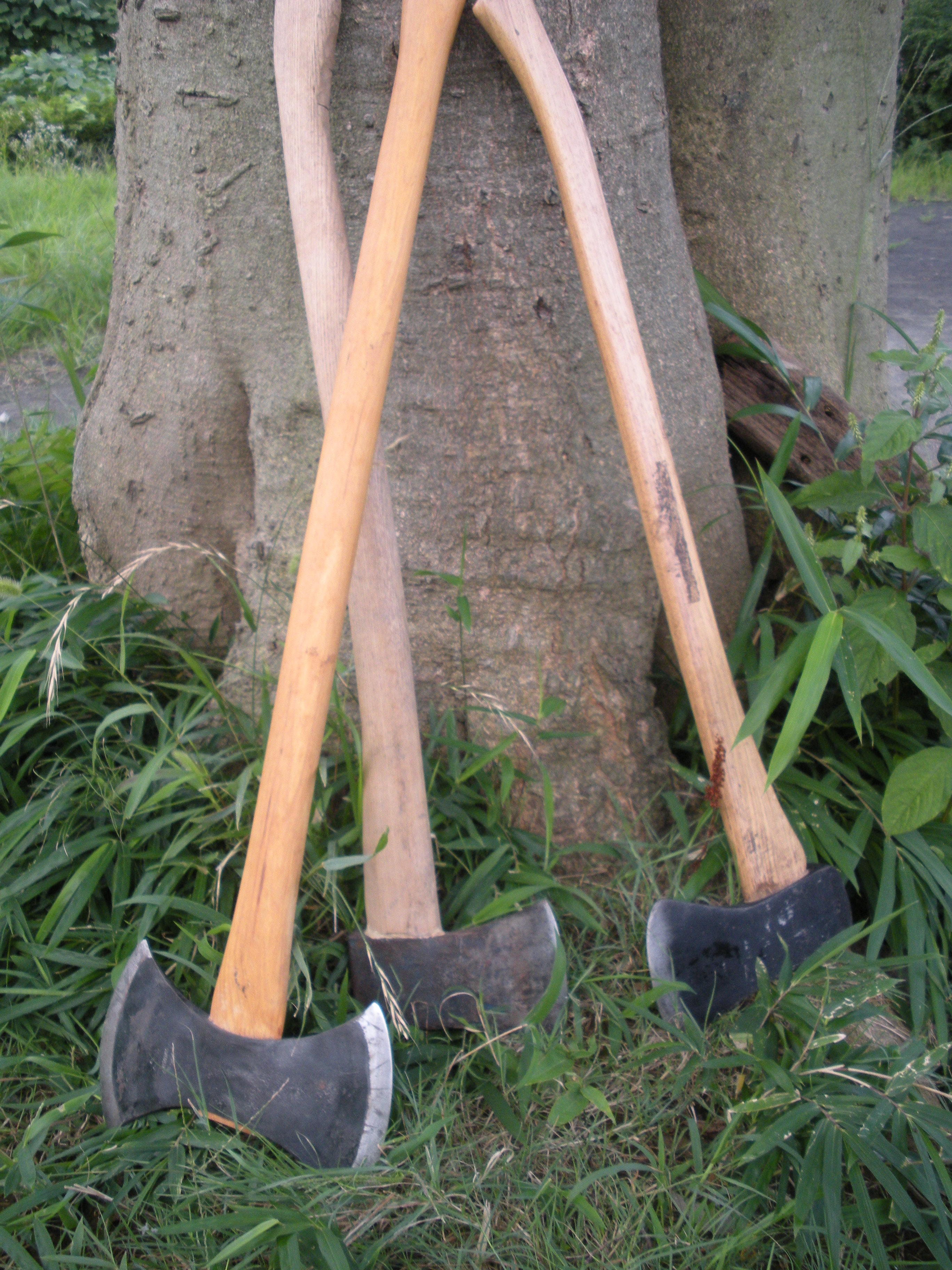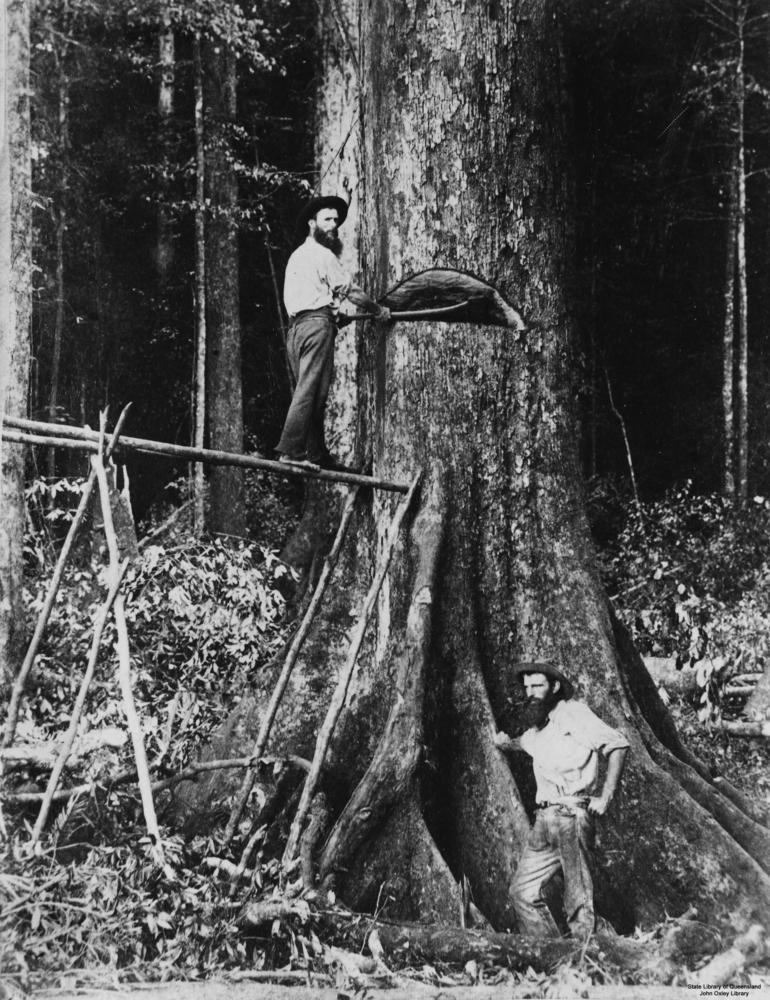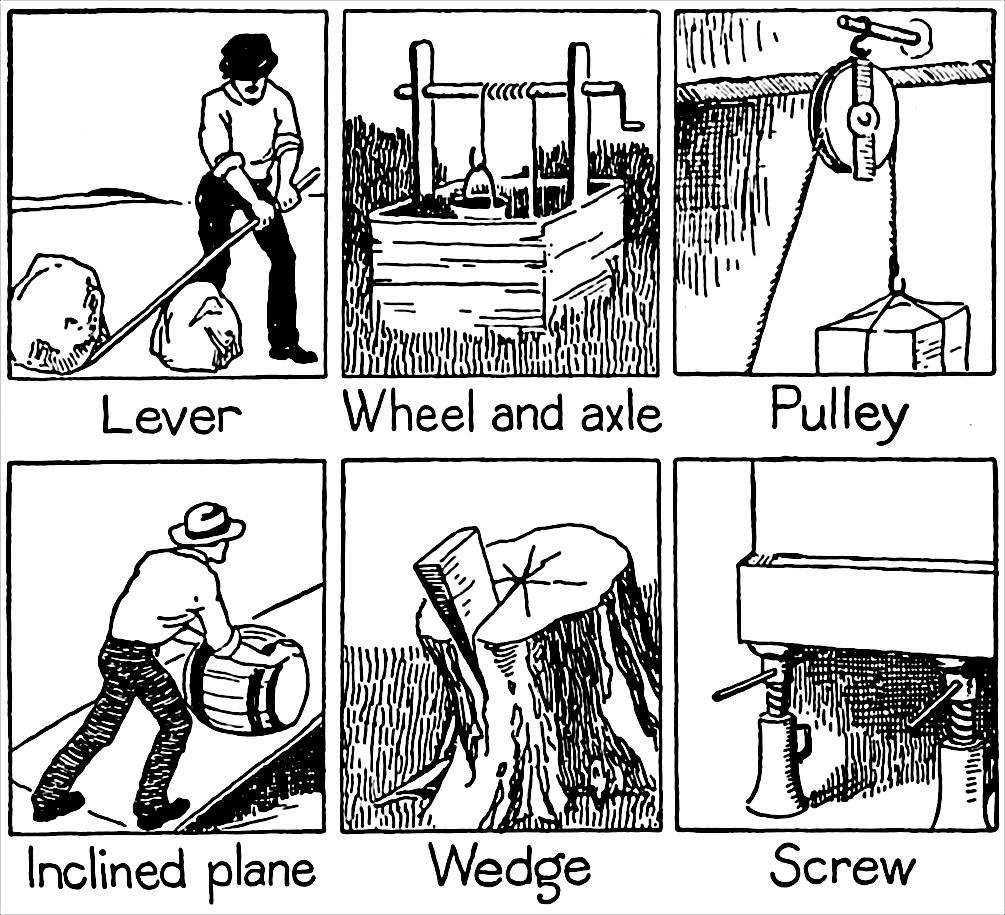|
Axe
An axe ( sometimes ax in American English; see spelling differences) is an implement that has been used for millennia to shape, split and cut wood, to harvest timber, as a weapon, and as a ceremonial or heraldic symbol. The axe has many forms and specialised uses but generally consists of an axe head with a handle, or ''helve''. Before the modern axe, the stone-age hand axe without a handle was used from 1.5 million years BP. Hafted axes (those with a handle) date only from 6000 BC. The earliest examples of handled axes have heads of stone with some form of wooden handle attached ( hafted) in a method to suit the available materials and use. Axes made of copper, bronze, iron and steel appeared as these technologies developed. The axe is an example of a simple machine, as it is a type of wedge, or dual inclined plane. This reduces the effort needed by the wood chopper. It splits the wood into two parts by the pressure concentration at the blade. The handle of t ... [...More Info...] [...Related Items...] OR: [Wikipedia] [Google] [Baidu] |
Battle Axe
A battle axe (also battle-axe, battle ax, or battle-ax) is an axe specifically designed for combat. Battle axes were specialized versions of utility axes. Many were suitable for use in one hand, while others were larger and were deployed two-handed. Axes designed for warfare ranged in weight from just over , and in length from just over to upwards of , as in the case of the Danish axe or the sparth axe. Cleaving weapons longer than 150 cm would arguably fall into the category of polearms. Overview Through the course of human history, commonplace objects have been pressed into service as weapons. Axes, by virtue of their ubiquity, are no exception. Besides axes designed for combat, there were many battle axes that doubled as tools. Axes could be modified into deadly projectiles as well (see the francisca for an example). Axes were often cheaper than swords and considerably more available. Battle axes generally weigh far less than modern splitting axes, especially ma ... [...More Info...] [...Related Items...] OR: [Wikipedia] [Google] [Baidu] |
Woodchopping
Woodchopping (also spelled wood-chopping or wood chopping), called woodchop for short, is a sport that has been around for hundreds of years in several cultures. In woodchopping competitions, skilled contestants attempt to be the first to cut or saw through a log or other block of wood. It is often held at state fairs and agricultural shows. Participants (especially men) are often referred to as axemen. History The modern sport of woodchopping is said to have had its genesis in 1870 in Ulverstone, Tasmania, as the result of a £25 ($50) bet between two axemen as to who could first fell a tree. An alternative origin story comes from 16th century Basque Country, in which a man ran a marathon and chop ten logs to be allowed to propose to his future wife. The world's first woodchopping championship was held in 1891, at Bell's Parade, Latrobe, Tasmania. This event was celebrated and commemorated with the selection of the site to be the home of the Australian Axemen's Hall of Fame ... [...More Info...] [...Related Items...] OR: [Wikipedia] [Google] [Baidu] |
Hand Axe
A hand axe (or handaxe or Acheulean hand axe) is a prehistoric stone tool with two faces that is the longest-used tool in human history, yet there is no academic consensus on what they were used for. It is made from stone, usually flint or chert that has been "reduced" and shaped from a larger piece by knapping, or hitting against another stone. They are characteristic of the lower Acheulean and middle Palaeolithic ( Mousterian) periods, roughly 1.6 million years ago to about 100,000 years ago, and used by ''Homo erectus'' and other early humans, but rarely by ''Homo sapiens''. Their technical name (biface) comes from the fact that the archetypical model is a generally bifacial (with two wide sides or faces) and almond-shaped (amygdaloidal) lithic flake. Hand axes tend to be symmetrical along their longitudinal axis and formed by pressure or percussion. The most common hand axes have a pointed end and rounded base, which gives them their characteristic almond shape, and b ... [...More Info...] [...Related Items...] OR: [Wikipedia] [Google] [Baidu] |
Broadaxe
A broadaxe is a large (broad)-headed axe. There are two categories of cutting edge on broadaxes, both are used for shaping logs by hewing. On one type, one side is flat, and the other side beveled, a basilled edge, also called a side axe, single bevel, or chisle-edged axe. On the other type, both sides are beveled, sometimes called a double bevel axe, which produces a scalloped cut. On the basilled broadaxe the handle may curve away from the flat side to allow an optimal stance by the hewer in relation to the hewn surface. The flat blade is to make the surface flat but can only be worked from one direction and is right-handed or left-handed. The double bevel axe has a straight handle and can be swung with either side against the wood. A double beveled broad axe can be used for chopping or notching as well as hewing. When used for hewing, notches are chopped in the side of the log down to a marked line, a process called scoring. The pieces of wood between these notches are remov ... [...More Info...] [...Related Items...] OR: [Wikipedia] [Google] [Baidu] |
Hafting
Hafting is a process by which an artifact, often bone, stone, or metal is attached to a ''haft'' (handle or strap). This makes the artifact more useful by allowing it to be shot (arrow), thrown by hand (spear), or used with more effective leverage (axe). When constructed properly, hafting can tremendously improve a weapon's damage and range. It is estimated that hafted weapons were most common during the Upper Paleolithic and Middle Paleolithic. It was one of the first tools where hominins took separate elements and united them into a single tool. The development of hafting is considered by archaeologists to have been a significant milestone. It was not only an improvement in the technology at the time; it also showed the progression of the human mind toward a world of complex tool-making. Hafting weapons is perhaps best known for its use by humans in prehistory, but it is still practiced by enthusiasts today and the handle of a tool such as an axe is still known as a haft. Many ... [...More Info...] [...Related Items...] OR: [Wikipedia] [Google] [Baidu] |
Copper
Copper is a chemical element with the symbol Cu (from la, cuprum) and atomic number 29. It is a soft, malleable, and ductile metal with very high thermal and electrical conductivity. A freshly exposed surface of pure copper has a pinkish-orange color. Copper is used as a conductor of heat and electricity, as a building material, and as a constituent of various metal alloys, such as sterling silver used in jewelry, cupronickel used to make marine hardware and coins, and constantan used in strain gauges and thermocouples for temperature measurement. Copper is one of the few metals that can occur in nature in a directly usable metallic form (native metals). This led to very early human use in several regions, from circa 8000 BC. Thousands of years later, it was the first metal to be smelted from sulfide ores, circa 5000 BC; the first metal to be cast into a shape in a mold, c. 4000 BC; and the first metal to be purposely alloyed with another metal, tin, to create br ... [...More Info...] [...Related Items...] OR: [Wikipedia] [Google] [Baidu] |
Wedge (mechanical Device)
A wedge is a triangular shaped tool, and is a portable inclined plane, and one of the six simple machines. It can be used to separate two objects or portions of an object, lift up an object, or hold an object in place. It functions by converting a force applied to its blunt end into forces perpendicular ( normal) to its inclined surfaces. The mechanical advantage of a wedge is given by the ratio of the length of its slope to its width..''McGraw-Hill Concise Encyclopedia of Science & Technology'', Third Ed., Sybil P. Parker, ed., McGraw-Hill, Inc., 1992, p. 2041. Although a short wedge with a wide angle may do a job faster, it requires more force than a long wedge with a narrow angle. The force is applied on a flat, broad surface. This energy is transported to the pointy, sharp end of the wedge, hence the force is transported. The wedge simply transports energy in the form of friction and collects it to the pointy end, consequently breaking the item. History Wedges have ex ... [...More Info...] [...Related Items...] OR: [Wikipedia] [Google] [Baidu] |
Felling Axe
Felling is the process of cutting down trees,"Feller" def. 2. and "Felling", def. 1. ''Oxford English Dictionary'' Second Edition on CD-ROM (v. 4.0) © Oxford University Press 2009 an element of the task of logging. The person cutting the trees is a ''feller''. A feller buncher is a machine capable of felling a single large tree or grouping and felling several small ones simultaneously. Methods Hand felling In hand felling, an axe, saw, or chainsaw is used to fell a tree, followed up by limbing and bucking in traditional applications. In the modern commercial logging industry, felling is typically followed by limbing and skidding. Feller buncher A feller-buncher is a motorized vehicle with an attachment which rapidly cuts and gathers several trees in the process of felling them. In cut-to-length logging a harvester performs the tasks of a feller-buncher, additionally doing the delimbing and bucking. When harvesting wood from a felled tree, the recommended methods ... [...More Info...] [...Related Items...] OR: [Wikipedia] [Google] [Baidu] |
Rock (geology)
In geology, rock (or stone) is any naturally occurring solid mass or aggregate of minerals or mineraloid matter. It is categorized by the minerals included, its Chemical compound, chemical composition, and the way in which it is formed. Rocks form the Earth's outer solid layer, the Earth's crust, crust, and most of its interior, except for the liquid Earth's outer core, outer core and pockets of magma in the asthenosphere. The study of rocks involves multiple subdisciplines of geology, including petrology and mineralogy. It may be limited to rocks found on Earth, or it may include planetary geology that studies the rocks of other celestial objects. Rocks are usually grouped into three main groups: igneous rocks, sedimentary rocks and metamorphic rocks. Igneous rocks are formed when magma cools in the Earth's crust, or lava cools on the ground surface or the seabed. Sedimentary rocks are formed by diagenesis and lithification of sediments, which in turn are formed by the weathe ... [...More Info...] [...Related Items...] OR: [Wikipedia] [Google] [Baidu] |
Bronze
Bronze is an alloy consisting primarily of copper, commonly with about 12–12.5% tin and often with the addition of other metals (including aluminium, manganese, nickel, or zinc) and sometimes non-metals, such as phosphorus, or metalloids such as arsenic or silicon. These additions produce a range of alloys that may be harder than copper alone, or have other useful properties, such as strength, ductility, or machinability. The archaeological period in which bronze was the hardest metal in widespread use is known as the Bronze Age. The beginning of the Bronze Age in western Eurasia and India is conventionally dated to the mid-4th millennium BCE (~3500 BCE), and to the early 2nd millennium BCE in China; elsewhere it gradually spread across regions. The Bronze Age was followed by the Iron Age starting from about 1300 BCE and reaching most of Eurasia by about 500 BCE, although bronze continued to be much more widely used than it is in modern times. Because histori ... [...More Info...] [...Related Items...] OR: [Wikipedia] [Google] [Baidu] |
Simple Machine
A simple machine is a mechanical device that changes the direction or magnitude of a force. In general, they can be defined as the simplest mechanisms that use mechanical advantage (also called leverage) to multiply force. Usually the term refers to the six classical simple machines that were defined by Renaissance scientists: * Lever * Wheel and axle * Pulley * Inclined plane * Wedge * Screw A simple machine uses a single applied force to do work against a single load force. Ignoring friction losses, the work done on the load is equal to the work done by the applied force. The machine can increase the amount of the output force, at the cost of a proportional decrease in the distance moved by the load. The ratio of the output to the applied force is called the '' mechanical advantage''. Simple machines can be regarded as the elementary "building blocks" of which all more complicated machines (sometimes called "compound machines") are composed. For example, wheels, lev ... [...More Info...] [...Related Items...] OR: [Wikipedia] [Google] [Baidu] |
Iron
Iron () is a chemical element with symbol Fe (from la, ferrum) and atomic number 26. It is a metal that belongs to the first transition series and group 8 of the periodic table. It is, by mass, the most common element on Earth, right in front of oxygen (32.1% and 30.1%, respectively), forming much of Earth's outer and inner core. It is the fourth most common element in the Earth's crust. In its metallic state, iron is rare in the Earth's crust, limited mainly to deposition by meteorites. Iron ores, by contrast, are among the most abundant in the Earth's crust, although extracting usable metal from them requires kilns or furnaces capable of reaching or higher, about higher than that required to smelt copper. Humans started to master that process in Eurasia during the 2nd millennium BCE and the use of iron tools and weapons began to displace copper alloys, in some regions, only around 1200 BCE. That event is considered the transition from the Bronze Age to the ... [...More Info...] [...Related Items...] OR: [Wikipedia] [Google] [Baidu] |





.jpg)




